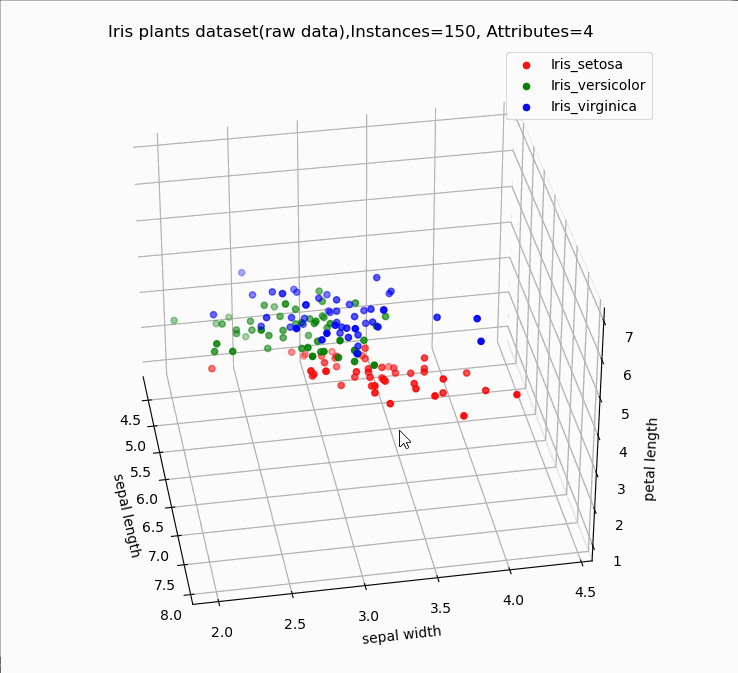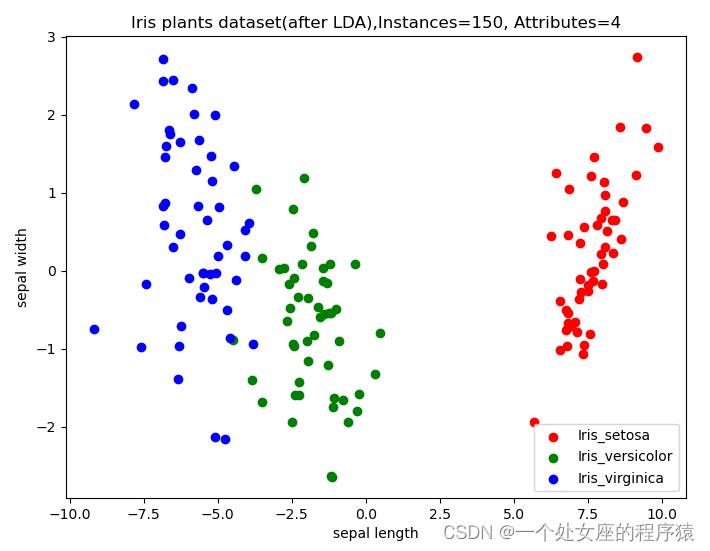ML之DR:基于鸢尾花(Iris)数据集利用多种降维算法(PCA/TSVD/LDA/TSNE)实现数据降维并进行二维和三维动态可视化应用案例
目录
基于鸢尾花(Iris)数据集利用多种降维算法(PCA/TSVD/LDA/TSNE)实现数据降维并进行二维和三维动态可视化应用案例
相关文章
ML之DR:基于鸢尾花(Iris)数据集利用多种降维算法(PCA/TSVD/LDA/TSNE)实现数据降维并进行二维和三维动态可视化应用案例
ML之DR:基于鸢尾花(Iris)数据集利用多种降维算法(PCA/TSVD/LDA/TSNE)实现数据降维并进行二维和三维动态可视化应用案例实现代码
基于鸢尾花(Iris)数据集利用多种降维算法(PCA/TSVD/LDA/TSNE)实现数据降维并进行二维和三维动态可视化应用案例
# 1、定义数据集
.. _iris_dataset:
Iris plants dataset
--------------------
**Data Set Characteristics:**
:Number of Instances: 150 (50 in each of three classes)
:Number of Attributes: 4 numeric, predictive attributes and the class
:Attribute Information:
- sepal length in cm
- sepal width in cm
- petal length in cm
- petal width in cm
- class:
- Iris-Setosa
- Iris-Versicolour
- Iris-Virginica
:Summary Statistics:
============== ==== ==== ======= ===== ====================
Min Max Mean SD Class Correlation
============== ==== ==== ======= ===== ====================
sepal length: 4.3 7.9 5.84 0.83 0.7826
sepal width: 2.0 4.4 3.05 0.43 -0.4194
petal length: 1.0 6.9 3.76 1.76 0.9490 (high!)
petal width: 0.1 2.5 1.20 0.76 0.9565 (high!)
============== ==== ==== ======= ===== ====================
:Missing Attribute Values: None
:Class Distribution: 33.3% for each of 3 classes.
:Creator: R.A. Fisher
:Donor: Michael Marshall (MARSHALL%PLU@io.arc.nasa.gov)
:Date: July, 1988
The famous Iris database, first used by Sir R.A. Fisher. The dataset is taken
from Fisher's paper. Note that it's the same as in R, but not as in the UCI
Machine Learning Repository, which has two wrong data points.
This is perhaps the best known database to be found in the
pattern recognition literature. Fisher's paper is a classic in the field and
is referenced frequently to this day. (See Duda & Hart, for example.) The
data set contains 3 classes of 50 instances each, where each class refers to a
type of iris plant. One class is linearly separable from the other 2; the
latter are NOT linearly separable from each other.
.. topic:: References
- Fisher, R.A. "The use of multiple measurements in taxonomic problems"
Annual Eugenics, 7, Part II, 179-188 (1936); also in "Contributions to
Mathematical Statistics" (John Wiley, NY, 1950).
- Duda, R.O., & Hart, P.E. (1973) Pattern Classification and Scene Analysis.
(Q327.D83) John Wiley & Sons. ISBN 0-471-22361-1. See page 218.
- Dasarathy, B.V. (1980) "Nosing Around the Neighborhood: A New System
Structure and Classification Rule for Recognition in Partially Exposed
Environments". IEEE Transactions on Pattern Analysis and Machine
Intelligence, Vol. PAMI-2, No. 1, 67-71.
- Gates, G.W. (1972) "The Reduced Nearest Neighbor Rule". IEEE Transactions
on Information Theory, May 1972, 431-433.
- See also: 1988 MLC Proceedings, 54-64. Cheeseman et al"s AUTOCLASS II
conceptual clustering system finds 3 classes in the data.
- Many, many more ...# 2、数据预处理/特征工程
# 2.1、可视化原数据集


# 2.2、降维数据集可视化:包括二维、三维图可视化
# T1、PCA降维可视化


# T2、TSVD降维可视化


# T3、LDA降维可视化

# T4、TSNE降维可视化




























 1159
1159











 被折叠的 条评论
为什么被折叠?
被折叠的 条评论
为什么被折叠?










